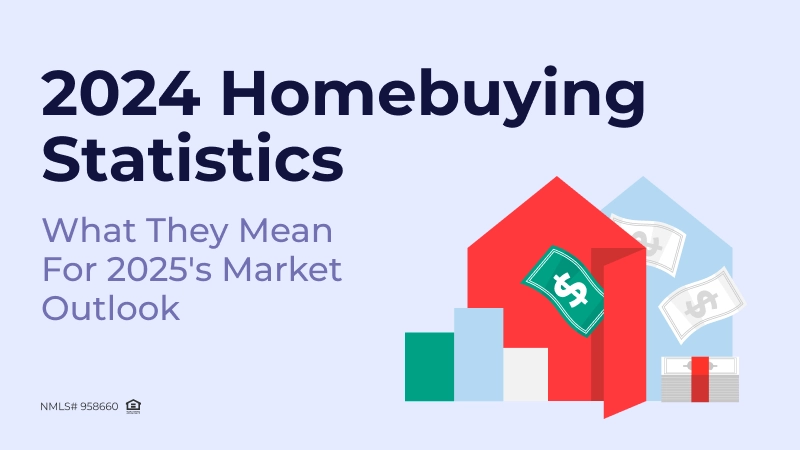2024 was a year of significant changes in the housing market. Home prices, once soaring, started to cool down, albeit slowly. Interest rates, after a rapid climb, began to stabilize. Meanwhile, the share of first-time homebuyers fell to historic lows, underscoring affordability challenges and shifting buyer demographics. These developments have left many homebuyers and mortgage professionals wondering: What does 2025 have in store? We’ll analyze the most critical homebuyer statistics from 2024 and explore their implications for the 2025 housing market. We’ll provide an overview of 2024 housing market trends, the key factors driving these changes, predictions for 2025, and actionable mortgage industry insights.
By understanding the 2024 homebuyer statistics and their potential impact on the upcoming market, you can better anticipate shifts in borrower behavior, lending trends, and housing affordability. It will help you adapt to current conditions, identify the best opportunities for your clients and position yourself to deliver optimal results.
Overview of 2024 Homebuying Statistics
2024 was a year of mixed signals in the housing market. While some trends have continued from previous years, new dynamics have emerged, shaping the landscape for both buyers and sellers. Let’s have a closer look at the key areas.
The 2024 housing market presents a mixed picture, with notable variations in both existing and new home sales.
According to the National Association of Realtors (NAR), “Existing-home sales climbed 3.4% in October to a seasonally adjusted annual rate of 3.96 million. Sales advanced 2.9% from one year ago, the first year-over-year increase in more than three years (July 2021; +1.8%).” NAR Chief Economist Lawrence Yun suggested that “the worst of the downturn in home sales could be over, with increasing inventory leading to more transactions.”
Meanwhile, new single-family home sales experienced a decline. The U.S. Census Bureau reported that in October 2024, new home sales were down 17.3% compared to September and 9.4% lower than in October 2023. This decline highlights ongoing challenges in the new home market, including affordability and supply chain pressures.
Although mortgage rates fell to their lowest levels in two years, offering some hope for buyers, overall home sales still decreased. Homebuyer statistics from Freddie Mac show that combined new and existing home sales dropped by 2.9% in August, followed by a 0.2% decline in September. This marked a downturn despite more favorable financing conditions. Existing home sales reached their lowest levels since October 2010, while new home sales fell to 716,000 units.
Despite these challenges, signs of recovery are emerging. As Selma Hepp, chief economist at CoreLogic, noted, “Lower mortgage rates would help spur home sales activity. Declines in mortgage rates [would] drive more sellers to trade their existing home and help add much-needed inventory to the market, leading to more transactions.”
Buyer Demographics
Millennials continued to dominate the homebuying market in 2024. It is a trend that has been consistent for several years. According to NAR’s 2024 Home Buyers and Sellers Generational Trends Report, millennials (those aged 25 to 43) made up 38% of all homebuyers, driven by their desire “to own a home of their own” as many are starting families or working remotely.
Gen Z buyers are now just beginning to enter the market. A rising number of them are opting for first-time home purchases. According to NAR’s 2024 Home Buyers and Sellers Generational Trends Report, they “made up just three percent of buyers; this group is entering homeownership with the lowest household incomes, and its members are unlikely to be married yet, and are not likely to have children under the age of 18 in their home. Similar to Young Millennials, they purchase older homes than other buyers.”
Choose a top nationwide lender that cares about your growth!
Get Started
First-time buyers have been experiencing a gradual decline in their market share, with the percentage reaching “a historic low of 24%” in 2024. This marks a stark contrast to previous years when first-time buyers made up a larger portion of the market (32%). Many first-time buyers have been hindered by high home prices, rising interest rates, and limited inventory. On the contrary, the share of repeat buyers has increased, as existing homeowners take advantage of current market conditions to upgrade or invest in additional properties. As CNN stated, “First-time homebuyers may have trouble competing with repeat buyers, who could possibly have sold an existing home to purchase a new one. Repeat buyers were able to enter the housing market with much larger down payments (median 23%) than first-time homebuyers (median 9%). Thirty-one percent of repeat buyers paid all cash for their homes.”
Regional Variations
Differing Market Performance Across Region
Regionally, the housing market presents a varied picture. October homebuyer statistics from the NAR highlighted that existing home sales were robust in the Midwest, South, and West, but unchanged in the Northeast, reflecting regional economic and demographic differences.
Inventory Trends in Major Regions
According to the October 2024 Monthly Housing Market Trends Report, in terms of inventory, all four major regions – the South, West, Midwest, and Northeast – saw year-over-year increases in October. The South led with a significant 34.0% rise in active listings, followed closely by the West at 33.6%, the Midwest at 19.8%, and the Northeast at 14.3%.
Price Trends and Local Market Strength
Price trends also varied significantly by region. Listing prices in October 2024 reflected a slight upward trend in the Northeast (4.0%), Midwest (1.1%), and West (0.2%), while the South saw a 1.7% decline. Adjusted for price per square foot, however, all regions demonstrated growth ranging from 0.8% to 3.7%, suggesting stronger underlying demand across the board. Notably, metro areas such as Rochester, Milwaukee, and St. Louis experienced double-digit price gains, emphasizing the strength of some local markets.
Home Price Appreciation According to FHFA
As Freddie Mac notes, home price appreciation, as measured by the FHFA House Price Index, further underlines these trends. U.S. home prices rose 4.5% annually through July 2024, with regional growth ranging from 7.5% in the East North Central division to 1.6% in the West South-Central division. This gradual cooling compared to the sharp spikes in 2022 marks a return to more sustainable growth, but the disparity between regions remains notable.
Urban, Suburban, and Exurban Shifts
The U.S. Census Bureau reported a continuation of migration from urban centers to suburban and exurban areas in 2024. Exurbs – regions beyond traditional suburbs – gained popularity, reflecting buyers’ preference for space and affordability as remote work trends persisted. Suburban areas near major employment hubs remained strong, while rural markets also saw notable growth, albeit at a slower pace than during the peak of the pandemic.
Key Factors Influencing the 2024 Housing Market
The housing market is shaped by several key factors, including mortgage rates, inventory levels, construction trends, and broader economic conditions. Understanding these drivers can help you prepare for what lies ahead.
Mortgage Rates and Lending Practices
In 2024, the mortgage market underwent a notable shift, bringing new hope and opportunities for homebuyers and borrowers. After a period of soaring mortgage rates in 2022 and 2023, a gradual decline began in 2024, marking a turning point for the housing market. Starting in September, the Federal Reserve made a significant move by cutting rates by 50 basis points, signaling a change in the interest rate environment. This adjustment was followed by an additional 0.25-point reduction in November, further easing the financial pressure on borrowers.
These changes have opened the door for many homeowners to refinance their loans, particularly those who purchased homes at higher rates in recent years.
Lending standards in 2024 have shown signs of loosening, following a period of tightening. Financial institutions have relaxed some real estate lending criteria, especially for residential mortgages, as the economic outlook improved. However, financial institutions remain cautious, particularly for higher-risk loans like jumbo mortgages and home equity lines of credit (HELOCs). This shift reflects a balanced approach to risk management, where mortgage lenders are still selective but more willing to offer competitive terms to lower-risk borrowers.
Housing Supply and Demand
In 2024, housing supply and demand continued to be at the forefront of the market dynamics. It significantly impacted homebuyers and mortgage brokers. The Federal Reserve’s recent cycle of rate cuts has provided some relief, but it has not fully addressed the imbalance between housing supply and buyer demand. Home prices remain high, and while the market is seeing modest improvements in inventory, it’s still far from a balanced state.
According to Bankrate, as of September 2024, the overall housing inventory stood at 1.39 million units, a 23% increase from the previous year. This uptick in inventory is encouraging but still not enough to meet the pent-up demand. The nation had a 4.3-month supply of homes available for sale, a figure that is an improvement from last year but still well below the 5-6 months typically required for a balanced market. This ongoing shortage of homes has kept the market firmly in “seller’s territory,” with demand continuing to outpace supply, especially in popular metro areas.
Economic Indicators
Economic conditions had a significant impact on the housing market in 2024. GDP growth slowed to 2.8% but remained steady due to strong consumer spending. A slight rise in unemployment to 4.1% signaled a cooling labor market, impacting household incomes.
Inflation eased, with the PCE price index stabilizing at 2.8%, helping reduce pressure on budgets. Yet, high housing costs and mortgage rates continued to make homeownership difficult, especially in expensive areas.
Consumer confidence was mixed. Moderating inflation and rising wages offered some relief, but concerns over job stability and housing affordability kept optimism in check. These dynamics shaped a cautious housing market, balancing resilience with affordability challenges.
Notable Trends from 2024
Evolving consumer preferences and technological advancements have also contributed to significant shifts in the housing market this year. These trends are reshaping the way your clients approach homeownership and how you, as a mortgage professional, can best serve their needs.
Rise of Remote Work and Its Impact
One major trend is the continued influence of remote work on homebuyer preferences. No longer just a place to sleep and eat, homes have become multifunctional spaces for work, learning, and leisure. As a result, homebuyers are prioritizing features like dedicated home offices, high-speed internet access, and quiet spaces for focused work.
Although remote work has made relocating to less expensive regions more feasible, it has also led to significant housing price increases in rural and lower-density areas. As Harvard housing researcher Alex Hermann noted, “In the years following the pandemic, home prices rose a lot everywhere. But they rose especially rapidly in more rural areas, in smaller markets and in lower density counties of large metro areas.”
Technological Advances in Homebuying
In 2024, technology continued to transform the homebuying process. It became more convenient and efficient for both homebuyers and mortgage professionals. According to the National Association of REALTORS (NAR), “Among all generations of home buyers, the first step taken in the home search process was to look online for properties.” This trend reflects a growing preference for convenience and accessibility. Virtual tools have become a cornerstone of the homebuying experience. NAR’s 2024 homebuyer statistics highlight that virtual tours and detailed online property listings were critical for buyers, enabling them to explore homes remotely before committing to in-person visits. This shift was particularly influential for younger buyers and remote workers. They valued the flexibility of evaluating homes in various locations without travel.
Get the ADvantage
with our loyalty program
Earn and redeem points for valuable benefits for you and your clients
Unlock Rewards
Additionally, the mortgage process itself has undergone significant technological innovation. By becoming more accessible, online mortgage applications have begun to simplify the financing process, making it easier for your clients to get pre-approved and secure their dream homes.
Sustainability and Green Homes
Environmental consciousness is on the rise, and homebuyers are increasingly seeking homes that align with their values. According to the 2024 NAR Generational Trends Report, energy-saving and environmentally friendly features are highly valued across all age groups. Green certifications and features like solar panels and smart thermostats are also gaining popularity. They enhance both energy efficiency and resale value.
Predictions for the 2025 Housing Market Based on 2024 Data
The 2024 homebuyer statistics offer valuable insight into what we can expect in the housing market in 2025. While 2024 was marked by a mix of challenges and a slow recovery, several key trends are beginning to emerge. They will likely shape the market in the coming year.
Expected Mortgage Rate Movements
Recent Trends and Current Outlook
In 2024, mortgage rates showed some signs of relief with a decline. However, the outlook for 2025 remains uncertain. Economic conditions and the actions of the Federal Reserve will play a significant role in shaping the market.
Predictions for Stability
Some experts suggest that rates will remain relatively stable, barring unforeseen economic shocks. According to Norada Real Estate Investments, “I also believe that mortgage rates will likely remain stable in the near term, potentially supporting continued growth in sales. However, there’s always uncertainty related to inflation and economic conditions that could impact mortgage rates.”
Forecasts of Lower Rates
Others, such as Business Insider, predict that mortgage rates could fall. “We may not see mortgage rates drop much further this year since economic conditions have remained stable and future Fed cuts are already priced in. However, rates should go down in 2025.” This view is echoed by Ramsey Solutions, which states, “Mortgage rates will likely continue going down in 2025! The Federal Reserve (aka the Fed) lowered the federal funds rate in November, and mortgage rates should continue going down in response to that cut.”
Potential for Volatility
Zillow, on the other hand, predicts a more fluctuating rate environment. “Mortgage rates fell in September, briefly bringing the share of affordable listings to a 19-month high. They have since climbed back to nearly 7%, changing the affordability picture for home buyers. More swings like this are expected in 2025, with refinancing sprints occurring during the dips.”
As you can see, there aren’t unified mortgage rate predictions for 2025. Given these differing opinions, it’s important to closely monitor market conditions and the Federal Reserve’s actions. If the economy shows signs of overheating, it may prompt the Fed to increase rates, which could, in turn, lead to higher mortgage rates. On the other hand, if economic growth slows down, mortgage rates might continue their downward trend, potentially providing further opportunities for buyers.
Housing Affordability Outlook
The housing affordability picture heading into 2025 remains complex. While declining rates have eased the burden for some buyers, high home prices and limited inventory continue to present challenges.
Most experts agree that home prices will continue to rise, but the pace of those increases should moderate in 2025. As Business Insider reports, “Experts generally expect home prices to continue increasing, but the pace of those increases should slow in 2025.” Similarly, Ramsey Solutions notes that “the Federal Home Loan Mortgage Corporation expects prices to grow in 2025.”
HousingWire provides a more specific forecast, highlighting that “Realtor.com expects home-price growth of 3.7%, which is higher than most other forecasts.”
Overall, homebuyers in 2025 are likely to encounter ongoing affordability challenges due to high prices. More inventory expected to come onto the market. So, buyers may find it easier to identify options and potentially negotiate more favorable terms.
Shifts in Buyer Demographics
Millennials are likely to continue to dominate the market in 2025. However, as younger generations, such as Gen Z, enter the workforce and start families, we may see a gradual shift in buyer demographics. These younger buyers are often tech-savvy and prioritize sustainable living, influencing the types of homes they seek and the features they value.
Potential Challenges and Opportunities
Looking ahead to 2025, several challenges and opportunities may shape the housing market for homebuyers and mortgage brokers. Among the most pressing challenges are the ongoing inventory shortages and affordability concerns that dominated much of 2024. These factors have kept the housing supply tight, driving up prices and limiting options for buyers.
However, signs of relief are beginning to emerge. Inventory levels have begun to rise, and Zillow anticipates further improvements in 2025. According to Zillow, “While affordability challenges will remain, buyers should expect more homes on the market, meaning more time to consider their options and more leverage in negotiations.” This gradual increase in inventory could provide opportunities. With more listings available, your clients may have greater flexibility to find homes that meet their needs and budgets. It can potentially reduce the competition that has characterized recent years. Inventory levels are showing signs of improvement. Therefore, investors may find deals in distressed properties that can be renovated for flipping or held as rental assets. Suburban and exurban areas continue to attract buyers due to affordability, making them promising markets for long-term investments.
Another factor to watch is the trajectory of mortgage rates. Stabilizing or declining rates could create opportunities for homeowners to refinance and lower their monthly payments. At the same time, favorable rates may motivate hesitant buyers to enter the market.
Economic uncertainty remains a wildcard. Norada Real Estate Investments warns that “The overall economic climate remains a cause for concern. A potential recession or other economic downturn could significantly impact the housing market.”
Implications for Mortgage Brokers and Real Estate Professionals
With the significant changes in buyer demographics, market dynamics, and technological advancements that the 2024 homebuyer statistics represent, it will be critical for you as a mortgage professional to refine your strategies to prepare for shifts in 2025.
Adapting to Market Changes
You should first align your services with the realities of the current market. For example, the historically low share of first-time homebuyers in 2024 highlights affordability as a central challenge. You can consider introducing tailored loan products, such as low-down-payment or adjustable-rate mortgages, to better serve this segment. Repeat buyers, representing a larger portion of the market, may benefit from bridge loans or cash-out refinancing.
Leveraging Technology
Technology remains an essential tool in serving today’s borrowers. The increased reliance on online property searches and virtual tools underscores the importance of seamless digital solutions. Offering easy-to-navigate online applications, automated pre-qualification, and virtual consultations improve efficiency and attract tech-savvy Millennials and Gen Z homebuyers.
Focusing on Customer Education
Customer education is another critical area to focus on. Many potential homebuyers remain uncertain about fluctuating mortgage rates, affordability, and their own eligibility. You can address this by offering workshops, webinars, or one-on-one consultations to provide a clear picture of market conditions.
Conclusion
The 2024 homebuyer statistics show that the housing market has been full of twists and turns. But the trends we’ve seen offer valuable insights for the road ahead. The market is showing signs of recovery, since mortgage rates are stabilizing. There is a gradual increase in inventory and a more balanced regional picture. However, challenges remain. Affordability continues to be a hurdle, and the broader economic landscape remains uncertain. These insights highlight not only the challenges ahead but also the opportunities for mortgage professionals. Staying proactive and informed about these housing market trends, as well as educating your clients with clear, data-driven explanations will be essential for you in the 2025 market.
Looking to help your clients explore tailored mortgage options for the upcoming year? Whether you’re working with first-time homebuyers, repeat buyers, or investors, we’re here to provide expert solutions that align with their goals. Contact AD Mortgage today to get ready for a successful 2025.



